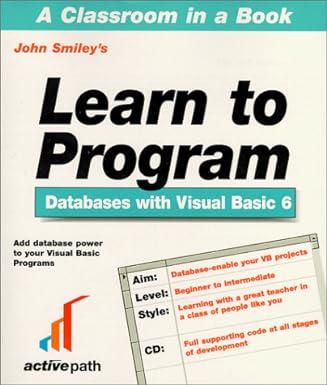Answered step by step
Verified Expert Solution
Question
1 Approved Answer
C++ code help! You will add some modifications to the code provided. The goal of this exercise to see which sorting algorithm is most efficient.
C++ code help!
You will add some modifications to the code provided. The goal of this exercise to see which sorting algorithm is most efficient. You should come up with different tests, such as using different size arrays. You should randomly generate the large integer arrays (1000+) and have a counter in the code that will count swaps or loops; either will be fine, but be consistent.
#include
//include correct libraries
using namespace std;
void quickSort(int arr[], int left, int right) {
int i = left, j = right;
int tmp;
int pivot = arr[(left + right) / 2];
/* partition */
while (i <= j) {
while (arr[i] < pivot)
i++;
while (arr[j] > pivot)
j--;
if (i <= j) {
tmp = arr[i];
arr[i] = arr[j];
arr[j] = tmp;
i++;
j--;
}
};
/* recursion */
if (left < j)
quickSort(arr, left, j);
if (i < right)
quickSort(arr, i, right);
}
void selectSort(int arr[], int n) {
int index_min_value;
int temp;
for (int i=0; i
// outer loop tracks the sorted portion of the list
index_min_value = i; //set index_min_value to the current index of array
for (int j=i+1; j < n; j++) // inner loop finds the next smallest value
{
if (arr[j] < arr[index_min_value])
index_min_value = j;
}
if (index_min_value != i) {
temp = arr[i];
arr[i] = arr[index_min_value];
arr[index_min_value] = temp;
}
}
}
void insertionSort (int arr[], int length) {
int j, temp;
for (int i = 0; i < length; i++) {
j = i;
while (j > 0 && arr[j] < arr[j-1])
{ // move elements over until find the position for next element
temp = arr[j];
arr[j] = arr[j-1];
arr[j-1] = temp;
j--;
}
}
}
void swap(int *xp, int *yp) {
int temp = *xp;
*xp = *yp;
*yp = temp;
}
void bubbleSort(int arr[], int n) {
int i, j;
for (i = 0; i < n-1; i++) {// Last i elements are already in place
for (j = 0; j < n-i-1; j++){
if (arr[j] > arr[j+1]){
swap(&arr[j], &arr[j+1]);
}
}
}
}
void printList(int arr[], int length){
for (int i = 0; i
cout<
}
cout<
}
int main(){
//HINT: You should place a counter into each algorithm to see how many time each of them run. Then you can compare them easier.
//You should use the given print statements for better organization.
int myArray1[] = {12, 13, 5, 4, 7, 18, 9 };
int myArray2[] = {12, 13, 5, 4, 7, 18, 9 };
int myArray3[] = {12, 13, 5, 4, 7, 18, 9 };
int myArray4[] = {12, 13, 5, 4, 7, 18, 9 };
cout << endl;
cout << " ======== Small array ======= " << endl;
cout << endl;
cout<<"My original small array is: "<
printList(myArray1,7);
//selectSort
selectSort(myArray1,7);
//cout<<"When ordered with selectSort, after "<
printList(myArray1,7);
//insertionSort
insertionSort(myArray2,7);
//cout<<"When ordered with insertionSort, after "<



printList(myArray2,7);
//bubbleSort
bubbleSort(myArray3,7);
//cout<<"When ordered with bubbleSort, after "<
printList(myArray3,7);
//quickSort
quickSort(myArray4,0,6);
//cout<<"When ordered with quickSort, after "<
printList(myArray4,7);
cout << endl;
cout << " ======== Large array ======= " << endl;
cout << endl;
//Begin with large arrays; test with each case and use the same print statements.
return 0;
}
Step by Step Solution
There are 3 Steps involved in it
Step: 1

Get Instant Access to Expert-Tailored Solutions
See step-by-step solutions with expert insights and AI powered tools for academic success
Step: 2

Step: 3

Ace Your Homework with AI
Get the answers you need in no time with our AI-driven, step-by-step assistance
Get Started


